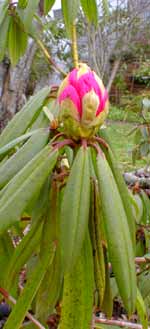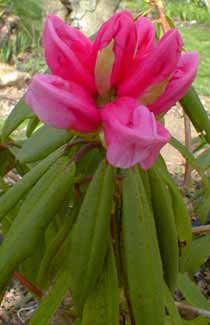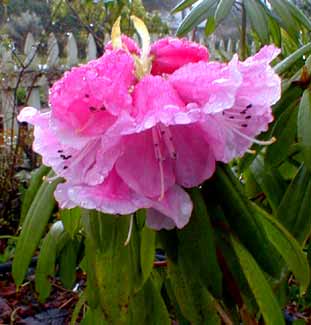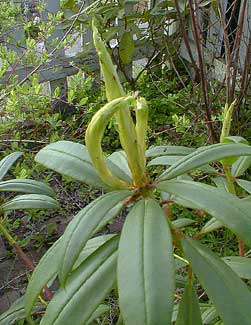
Rhododendron pachytrichum 'Sesame'
"Give me a golden pen, & let me lean
On heap'd up flowers, in regions clear, & far."
-John Keats
(1795-1821)
(1795-1821)
We obtained Rhododendron pachytrichum from a Rhododendron Species Foundation sale. It was started from a limb in 1994, & transferred to our garden in 2003, when it was only about three feet tall & two feet wide.
It could potentially reach twenty feet of height in its great old age, but inasmuch as it only grows four to six inches a year, I'm not holding my breath. In some future decade, however, the little hawthorn tree it grows beside might well need to be chopped down in favor of the rhody. The nearby rhody 'Alison Johnstone' might have to be transplanted from the location if these shrubs become large & crowded many years hence, but I'm hoping they'll blend together as mutually happy companions.
 In habit it is compact but partially opened, rounded, with upright central trunk, as much like a little tree as a shrub. Ours has pleasant limb structure so it's nice to be able to see into the heart of the shrub. It's hardy to zero degrees F., being native of subalpine woodlands & slopes in Sichuan, China, from about 8,000 feet to 11,500 feet, so quite used to chilly winters.
In habit it is compact but partially opened, rounded, with upright central trunk, as much like a little tree as a shrub. Ours has pleasant limb structure so it's nice to be able to see into the heart of the shrub. It's hardy to zero degrees F., being native of subalpine woodlands & slopes in Sichuan, China, from about 8,000 feet to 11,500 feet, so quite used to chilly winters.This is one of the species that Ernest "Chinese" Wilson (1876-1930) brought to the Arnold Arboretum during his botanical quests. He was first to introduce the west to the Paperbark Maple as well. There is today, in his birthplace of Gloucestershire, an Ernest Wilson Memorial Garden exclusively of his introductions.
 "Chinese Wilson" together with the French Lazarist priest Father Armand David (1826-1900) set out for the first time in 1863 from the Peking mission to explore the mountain wilderness's fauna & flora. In later journeys between 1868 & 1870, Wilson went into some of the most significant rhododendron regions of China & was the first westerner to see (alphabetically) RR argyrophyllum, calophytum, davidii, decorum, dendrocharis, floribundum, lutescens, moupinense, orbiculare, oreodoxa, pachytrichum, polylepis, & strigillosum.
"Chinese Wilson" together with the French Lazarist priest Father Armand David (1826-1900) set out for the first time in 1863 from the Peking mission to explore the mountain wilderness's fauna & flora. In later journeys between 1868 & 1870, Wilson went into some of the most significant rhododendron regions of China & was the first westerner to see (alphabetically) RR argyrophyllum, calophytum, davidii, decorum, dendrocharis, floribundum, lutescens, moupinense, orbiculare, oreodoxa, pachytrichum, polylepis, & strigillosum. Flower impact varies from specimen to specimen of R. pachytrichum, & some are not as nice as others. Some are very white with deep purple down in their throats; some have flush of pastel pink & burgundy in the throat; some have a yellow marking on pinkish white. Because of the varied appearances, it is often recommended to select one only while it is in flower. It blooms so early, however, that if one goes shopping for rhodies in spring, this species will already be finished. We crossed our fingers & got it with blooms sight-unseen.
 Having taken a chance, imagine our surprise the following year when our mystery purchase turned out to be a form that has been named 'Sesame,' which begins with the brightest pink buds at mid-February, that open pink before February ends, & become paler & paler toward mid-March. Buds do not all open simultaneously, so a few flowers will arrive late for late-March display.
Having taken a chance, imagine our surprise the following year when our mystery purchase turned out to be a form that has been named 'Sesame,' which begins with the brightest pink buds at mid-February, that open pink before February ends, & become paler & paler toward mid-March. Buds do not all open simultaneously, so a few flowers will arrive late for late-March display.'Sesame's' big pink buds open into seven to ten-inch trusses. The throat has a purple basal blotch & flecks. The first three photos on this page show the mid to late February (2004) progression. These large blooms never quite hide the branches, so that a shrub has more of the feel of magnolia in bloom.
This is our earliest-flowering rhododendron, but others that already have rich colorful buds about to burst include 'Milestone' & 'Crater's Edge,' with others to follow quickly in March, including 'PJM Elite.'
When the shrub is finished flowering, the tips of the branches develop "horns" that grow to be four to six inch long, sticky pale green leaf-buds. The fourth photo snapped in April (2003) shows these developing bent "horns" that occur in pairs & trios at branch terminals, occurring in pairs & trios. These are so large & strange they are only a little less stunning in impact than the early blossoms, having as they do an almost beast-like quality.
It drops its large leathery leaves in two-year cycles but always seems like a fully leafed evergreen.